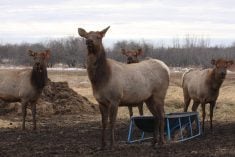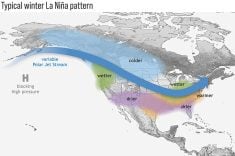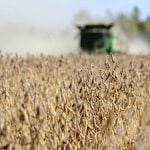SYDNEY, Australia (Reuters) – Estimates of Australia’s wheat crop could shrink this year as farmers delay planting, wary of poor prices, rising input costs and a potential locust plague.
Australia is the fourth-largest wheat exporter and accounts for 12 percent of world shipments. As a result, any cuts to forecasts could support world prices, especially if farmers elsewhere also hold back in response to prices languishing near five-year lows.
Early estimates are for a 22 to 22.5 million tonne crop, which is up from last year’s 21.7 million. Forecasters have called the forecast conservative, although some say the outlook could decrease.
Read Also

Canadian Food Inspection Agency extends chronic wasting disease control program consultation deadline
Date extended for consultation period of changes to CWD program
Paradoxically, recent rain has set up the best pre-planting conditions in years, but poor prices and rising fuel and fertilizer costs mean wheat looks like a loss-making crop to many farmers now deciding their planting intentions.
“Farmers have very tight budgets this year because of low grain prices and inputs are starting to go up again, so I think that’s going to reduce the area planted to wheat,” said Mike Norton, head of the Western Australian Farmers Federation.
Then there are the locusts.
The recent rain has spawned millions of locusts in northeastern Australia, which have already made a quick meal of early plantings as they swarm south through the grain belt.
Locusts are not viewed as a dramatic threat to the crop, but they can make a dent and add further uncertainty to the outlook.
Growers are taking a guarded approach to seeding in Western Australia, the country’s biggest grain exporting state that produces nearly half of Australia’s exports.
“Grain growers are approaching the growing season with caution,” the state government said in an April seasonal update.
More good rain, especially over Western Australia, could be enough to persuade farmers to plant a decent wheat crop, even though profits look marginal.
“What will be critical is how much rain Western Australia gets over the next four to six weeks,” said Wayne Gordon, a grains analyst at Rabobank in Sydney. “That will be a bigger swing factor than anything else.”
Western Australia’s grain regions need 25 millimetres of rain over the next four weeks to go ahead and plant, he added.
However, the state government said that there was an even chance of average or below-average rain in the crucial weeks ahead.
The U.S. Department of Agriculture estimates Australia’s farmers will plant 32.1 million acres this year, six percent less than the record 34.3 million acres planted last year.
Australia’s government commodities forecaster is more optimistic, forecasting the area will be cut only to 33.9 million acres.
Farmers may instead decide to devote more acreage to cotton, canola or pulses such as chickpeas, lupins and lentils, analysts and wheat industry insiders say.
Australian Prime White wheat, which is favored by Asian flour millers for noodles and buns, sells at around $195 Cdn per tonne, free-on-board, about $93 less than a year ago.
Some growers need $264 a tonne to break even.
Canola, on the other hand, is fetching around $390 a tonne.
“The rule of thumb is if canola prices are two-to-one or better, that implies canola is more profitable and, with better varieties, it is probably more so,” said Brett Cooper, senior manager of markets at trading firm FCStone Australia.
At current cotton prices, farmers are looking at returns four times that of wheat, while chickpeas fetch $325 to $371 per tonne.
“Grain growers have crunched the numbers and they reckon canola is all the go this year,” Norton said. “At current levels, wheat prices are becoming very marginal.”
Input prices, including fuel and fertilizer costs, are rising sharply. The price of diammonium phosphate, the key fertilizer used by Australian grain growers, has jumped nearly 30 percent since the start of the year as global demand picks up. Yields will fall if farmers cut fertilizer use.
“At these prices, profitability is a concern for farmers, so we’re likely to a see a shift out of wheat acres this year into alternative crops like canola,” Cooper said.
Switching acres out of wheat can also help rejuvenate their fields. Planting others crops, such as chickpeas and lupins, adds soil nutrients.
In the long term, this kind of rotation helps protect future wheat crops from disease.
Pulse Australia, which promotes pulse production, is calling for 2010-11 to be the year of paddock renovation during which underperforming fields should be sown with pulses to boost nutrients.
“We think canola plantings may be up around five percent and pulses will be up as well,” said Gavin Warburton, an analyst at Australian Crop Forecasters.














